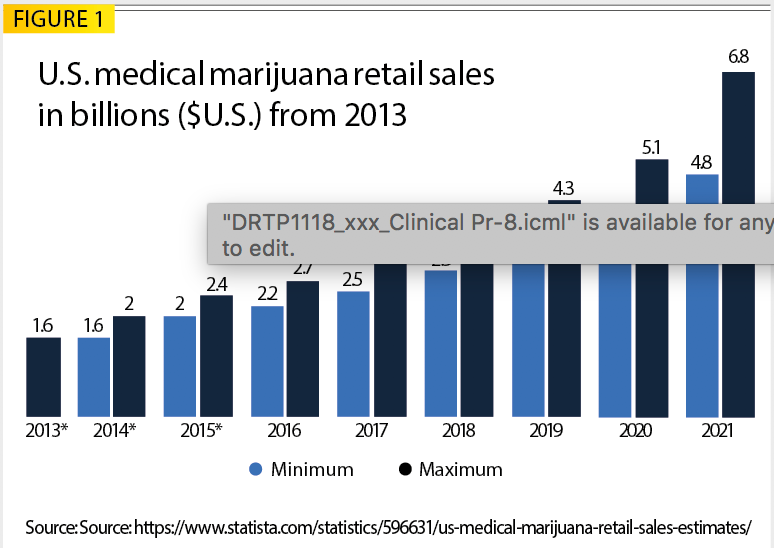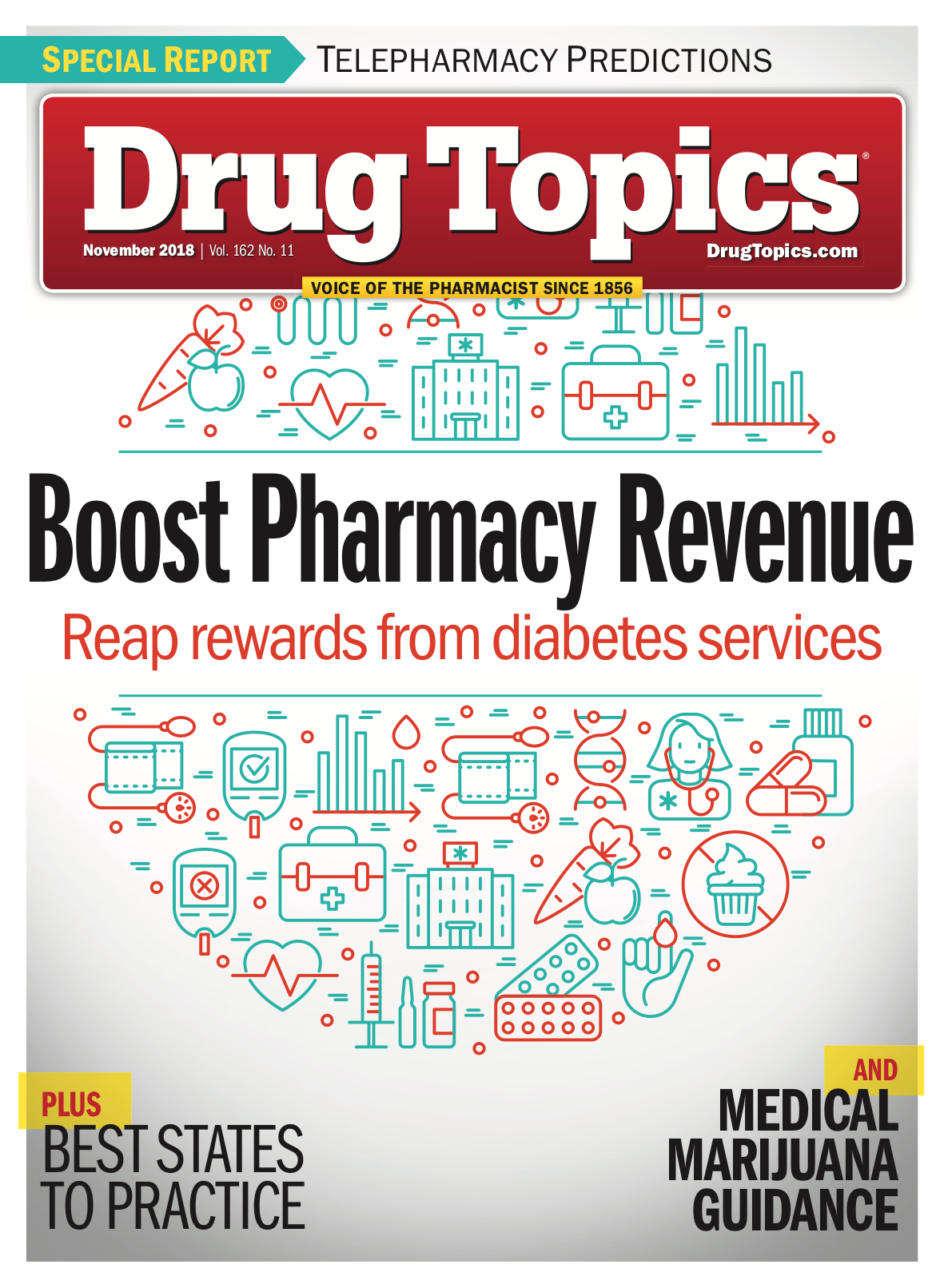Prescription Counseling Equally Applicable to THC Products
Pharmacists should prepare to advise patient consumption methods and THC drug interactions as use and manufacturing models continue to grow and legalize.

The closest exposure most pharmacists have to medical marijuana products in their day-to-day practice is likely to be with cannabinoids, such as dronabinol (Marinol, Syndros, THC) or the newly approved cannabidiol (CBD; Purified CBD, Epidiolex), according to William Kirchain, PharmD, CDE, Wilbur and Mildred Robichaux Endowed Professor at Xavier University of Louisiana College of Pharmacy. True medical marijuana, he says, refers to herbal products, which are sold through either marijuana dispensaries or specialty permitted marijuana pharmacies.
CBD and tetrahydrocannabinol (THC) are two natural compounds found in Cannabis, the marijuana plant. CBD does not cause the “high”; that comes from THC, which is the primary psychoactive component of marijuana.
While pharmacists must counsel patients thoroughly when they dispence Epidiolex or Marinol, all pharmacists should also be discussing medical and recreational use of marijuana with all their patients because marijuana can interact poorly with certain prescription medications and over-the-counter medications.
Studies indicate that more Americans are trying marijuana for recreational use and medicinal purposes as laws surrounding marijuana use have become more liberal. At press time, 31 states, and Washington, DC, allow comprehensive public medical marijuana and cannabis programs. Of those, nine have approved marijuana for recreational use.
Each state has its own laws about how patients can access medical marijuana.
Related: No Matter the Law, Pharmaciists Need to Know About Cannabis
In a controversial move, back in June 2018, Oklahoma voters voted to made it legal to use, sell, and grow marijuana for medicinal purposes in a referendum (State Question 788). The referendum passed despite pushback from conservative politicians and law enforcement groups.
Medical Marijuana Use Is Increasing
Estimates of past-year marijuana use has increased for middle-aged and older adults, according to a study published in Drug and Alcohol Dependence. The analysis comes from data gathered in the National Survey on Drug Use and Health from 2015 and 2016. About 9% of U.S. adults between ages 50 and 64 used marijuana in the previous year, according to survey results. About 3% of people over 65 used the drug in that time period.
In the 2016 study, almost one-quarter of Americans over age 65 who had used marijuana in the previous year said they received permission from their physicians. A January 2017 research overview published by the National Academies of Science, Engineering, and Medicine, showed that a still small but growing number of studies suggest that marijuana may be helpful in treating pain, nausea, and spasticity.
Medical marijuana can be marketed and sold in a variety of forms, as the properties of THC and CBD are used to produce a desired therapeutic response, Scott Tomerlin, PharmD, APhA spokesperson. Some of the latest trends in medical marijuana include the use of CBD oil in a variety of topical and oral preparations, he says.
“Other products that have gained popularity over recent years have included the use of hemp seed oil as well as the use of products containing CBD for veterinary use. E-cigarettes and other products which allow CBD to be inhaled in a vapor form, otherwise known as ‘vaping,’ are becoming increasingly popular on the marketplace as well,” he says.
There are more than 40 compounds in common CBD oils and extracts, and these products may vary in potency by a substantial amount even batch to batch. Some states allow use of “low THC, high CBD” products for medical reasons in limited situations.
Marijuana Interactions
Marijuana is metabolized through the liver, primarily through the CYP450 enzyme system, specifically 2C9, and 3A4 pathways, according to Deborah A. Pasko, PharmD, MHA, senior director for Medication Safety and Quality with ASHP.
“Drugs that undergo these same metabolic pathways are at risk of having a drug-drug interaction with marijuana. If the non-THC drug is an inducer it will lower concentrations of THC. If the non-THC drug is an inhibitor then it will elevate concentrations of THC,” Pasko says.
Knowing if a patient is being treated with medical marijuana establishes the opportunity for pharmacists to identify any potential drug interactions, especially if the patient may present with adverse effects that could be attributed to any recent changes in medication or over the counter use,” says Tomerlin. “It is always a good plan for the pharmacist to be fully equipped with as much information that is necessary to provide optimal patient care.”
Shital Mars, CEO of Progressive Care Inc., a healthcare and technology company with services that include medication therapy management, prescription pharmaceuticals, and compounded medications, says marijuana is generally well-tolerated in patients with mild to moderate risks of serious adverse side effects and/or dependence.
However, marijuana does have some notable drug interactions to consider before use. They include:
Just because there is a drug interaction, however, does not mean that the two substances cannot be used in combination, Mars says. With drug interactions, “it’s important that the doctor and pharmacist monitor harmful side effects or therapy inefficiencies. In many cases with the medications listed above, medical marijuana acts on the enzymes that either inhibit or induce the metabolic rate of the medication, meaning that interaction with medical marijuana can either increase the potency and effectiveness of the medication or decrease it.”
Kirchain says pharmacists should be aware of adverse reactions associated with marijuana use. These include: central nervous system depression, worsening of depression and other psychiatric illnesses, weight gain, and xerostomia.
Read More: Making the Case for Regulated Marijuana
There can be interactions with contaminates of marijuana products. “Smoked products may increase the risk of respiratory illness, and there have been reports of food-borne illness such as salmonella,” Kirchain says.
Other serious but rare adverse events associated with marijuana use include cannabis hyperemisis syndrome, characterized by recurrent nausea, vomiting, and crampy abdominal pain; cannabis-associated arteritis; and Takotsubo cardiomyopathy (also known as Takotsubo syndrome), a serious condition that includes sudden onset cardiovascular symptoms,” says Kirchain.
Marijuana Products
Smoking is the most common method of consumption of marijuana, but eating food products that contain marijuana (known as edibles) is quickly becoming a popular way to consume the drug. Although still illegal under federal and many state statutes, food products containing marijuana or marijuana extracts are currently common in states that either permit or that have declined to prosecute medical or recreational marijuana, according to the DEA.
“The differences of these products vary considerably based upon who and how the end product is manufactured,” Pasko says. “Marijuana scientists can alter the potency depending upon the section of the plant that is used, and also the total dose of THC in the compound.”
The marketplace for edible and smoked medical marijuana products is continuing to expand, with a plethora of options for patients to consider for use, according to Tomerlin. “Edible marijuana products may have the potential to be more potent than inhalable versions, but these products and the concentrations of THC and CBD can vary widely,” he says.
Smoked/vaped products will produce a more immediate effect on the body because the route through the lungs provides direct access to the blood, Mars says. “However, these effects should generally wear off much quicker than edible products and produce a less-intense psychologic effect even though the absorption of cannabinoids is higher than in edible products.”
Edibles take longer to achieve an effect because of the route through the gastrointestinal tract, according to Mars.
“Generally speaking, the issue is less that the person may die from ingesting too much through an edible, but rather they will be more impaired and may feel ill and experience nausea, vomiting, diarrhea, headaches, dizziness, etc.,” she says. “Pharmacists and physicians should be on the lookout for these side effects so that they can counsel their patients on how to avoid or handle them safely.”
Beyond the inhalable or edible route, topical preparations such as creams containing CBD oil, as well as other products-including lip balms and aromatic incense wicks to name a few-are readily available, according to Tomerlin.

What is Epidiolex?
Epidiolex is first FDA-approved drug comprised of an active ingredient derived from marijuana. It was approved in June 2018 for treatment of two rare severe forms of pediatric epilepsy.
The DEA gave a Schedule 5 classification to the antiseizure drug, the classification with the lowest degree of restriction, indicating the DEA believes it has a low potential for abuse.
Epidiolex is a purified CBD oil extract, says Kirchain.
Read More: What Pharmacists Need to Know About Epidiolex
Talking to Patients
Pharmacists should use the same approach with THC that they would counseling for any other medication, including discussing risks associated with impairment, toxicities, and long-term side effects, Pasko says.
When counseling patients who are using medical or recreational marijuana, pharmacists should also:
- Tell patients that it should not be used by pregnant women or women who are breastfeeding.
- Warn patients about the use of marijuana, medical or otherwise, in minors. “In some cases, medical marijuana has been prescribed to children with certain nervous system conditions,” Mars says. “In children, it is important to use medical marijuana with proper supervision and medical professional follow up. Used without such controls can subject a child to risk of psychotic and cognitive impairment conditions later in life.”
- Be wary of promises that are too good to be true. “It’s not magic,” Mars says. “There are many places that talk about the medicinal benefits or marijuana; however, one should be wary of promises that are too good to be true. Marijuana does have medicinal benefits that are now being confirmed through controlled clinical trials, but it should not be used a cure-all or catch-all for any condition a patient may have.”
- Keep a complete medication profile for patients including all OTC, herbal, illicit, and prescription medications. “Medication management services should be conducted when dispensing any medication,” Pasko says. “There should be a discussion about any other medication that they may be taking that could interact with the medical marijuana.”
